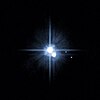Wikipedia:Today's featured article/October 7, 2007
Pluto is the second-largest known dwarf planet in the Solar System and the tenth-largest body observed directly orbiting the Sun. Originally classified as a planet, Pluto is now recognised as the largest member of a distinct region called the Kuiper belt. Like other members of the belt, it is primarily composed of rock and ice and is relatively small; approximately a fifth the mass of the Earth's Moon and a third its volume. It has an eccentric orbit that takes it from 30 to 49 AU (4.4–7.4 billion km) from the Sun, and is highly inclined with respect to the planets. As a result, Pluto occasionally comes closer to the Sun than the planet Neptune. Pluto and its largest moon, Charon, are often treated together as a binary system because the barycentre of their orbits does not lie within either body. The International Astronomical Union (IAU) has yet to formalise a definition for binary dwarf planets, and until it passes such a ruling, Charon is classified as a moon of Pluto. Pluto has two known smaller moons, Nix and Hydra, discovered in 2005. From the time of its discovery in 1930 until 2006, Pluto was counted as the Solar System's ninth planet. (more...)
Recently featured: New York City – Orion (mythology) – Kingdom Hearts (series)

